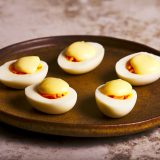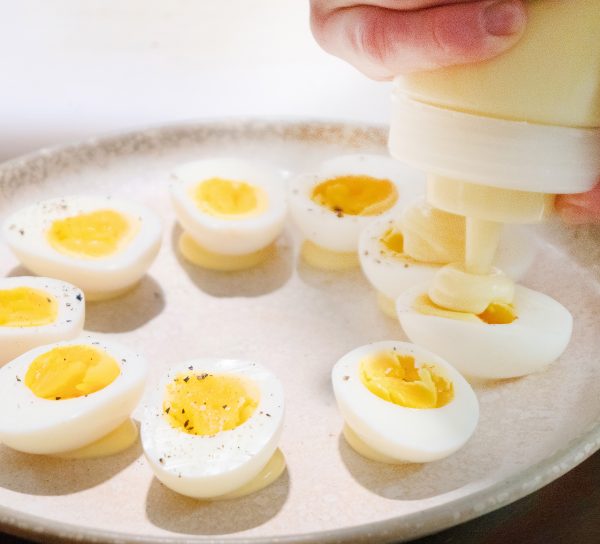
At Le Saint Sebastien in Paris, Christopher Edwards taught us the French bistro classic oeuf mayo. It turned out to be a master class in hard-cooking eggs and making mayonnaise by hand.
I was on a mission in Paris to learn French bistro classics, from oeuf mayo to leeks vinaigrette. I started with Christopher Edwards, chef of Le Saint Sebastien, whose oeuf mayo recipe is award-winning; he took second place at the 2021 Oeuf Mayo World Championship using a mayonnaise flavored with smoky Morteau sausage.
Just the name, oeuf mayonnaise, may inspire fear of cholesterol (total calories per serving, however, is just 100), but any dish championed by Joël Robuchon and Alice Waters deserves another look. In fact, L’Association pour la Sauvegarde de l’Oeuf Mayonnaise was founded in 1990 to promote it.
What is oeuf mayo? It is a perfectly hard-cooked egg (white firm, yolk moist but solid) topped with a dollop of mustardy mayonnaise. This is a story not just about the recipe, but also a lesson in properly cooking eggs so they peel easily and making mayonnaise by hand. Let’s begin.
The first step is to properly cook the eggs. J. Kenji López-Alt had the last word on hard-cooked eggs in his 2019 New York Times article, for which he enlisted the help of nearly 100 home cooks. The result? Steaming, López-Alt said, was the key to success.
So, when Edwards plunged a dozen eggs into hard-boiling water, I was surprised. He cooked them for exactly 8 minutes 40 seconds, then cooled them in a large ice bath for 3 minutes. I watched as he peeled all 12 eggs quickly, perfectly and easily. (My takeaway was that the ice bath was the key to success, but after thorough testing back at Milk Street, it turns out that I was only half right.)
On to the mustard mayo. First, allow me the opportunity to chastise the French about mustard. They love it so much that they abandon good culinary practice and assault leeks, greens and other unsuspecting vegetables with a mortal blanket of mustard. But here, I am happy to say, Edwards used a modest tablespoon of mustard in his mayonnaise.
To make the mayonnaise, Edwards first whisked the mustard with 3 egg yolks and salt. He then slowly drizzled in sunflower oil, whisking all the while. For a more stable emulsion, he added lemon juice and cold water. The mayo is done once it’s the right color (pale yellow) and texture (silky smooth and almost pudding-like). A tip from Edwards: If the mayo breaks, add one egg yolk and a bit of mustard to a large bowl and slowly whisk in the broken mixture.
To finish the oeufs, Edwards sliced the eggs in half, dabbed a little mayo on the rounded bottom of each to fix them in place, then piped on a squiggle of mustard mayo. For anyone who questions topping a hard-cooked egg with mayonnaise, I respond, “What about egg salad?”
The toothsome egg white, the moist, rich egg yolk and the creamy but slightly spicy topping of mustard mayonnaise make oeuf mayo a classic bistro dish for a reason. With a glass of chilled riesling or Sancerre, it is a perfect example of why simplicity is the highest expression of the culinary arts.
The Final Word on Peeling Hard-Cooked Eggs? Maybe.
J. Kenji López-Alt had convinced me, in a 2019 New York Times article, that steaming was the key to success when hard-cooking and peeling eggs. My visit with French chef Christopher Edwards, however, shifted my attention to the cooling period. He demonstrated how a large ice bath was key, since it cooled the hot eggs quickly, shrinking them so they separate from the shells. (A thin protein membrane cements the egg to its shell, but shocking the boiled egg in ice water causes the egg white, or albumen, to shrink and pull away from the membrane, making it easier to peel. The larger the volume of ice water, the more quickly the heat from the egg is absorbed, and the more effectively the albumen will shrink.) However, and this is where López-Alt and I agree, cooking eggs in a hot environment is critical—a cold start always produces hard-to-peel eggs. (In our tests, roughly half of the cold-start eggs were hard to peel.) I found that boiling edged out steaming, but take your pick. In our testing, boiling for 6 to 6½ minutes gave us perfectly just-runny yolks; 8½ to 9 minutes for medium yolks; and 12½ to 13 minutes for hard-cooked yolks. As for the ice bath, our tests showed that one tray of ice cubes plus 2 cups of water is the minimum required for 4 eggs, so 12 eggs require three trays and 6 cups. Chill for 3 minutes and be sure that the eggs are fully submerged. Running the eggs under cold water for the same amount of time also worked, but not nearly as well as the ice bath.
Easy-Peel Eggs
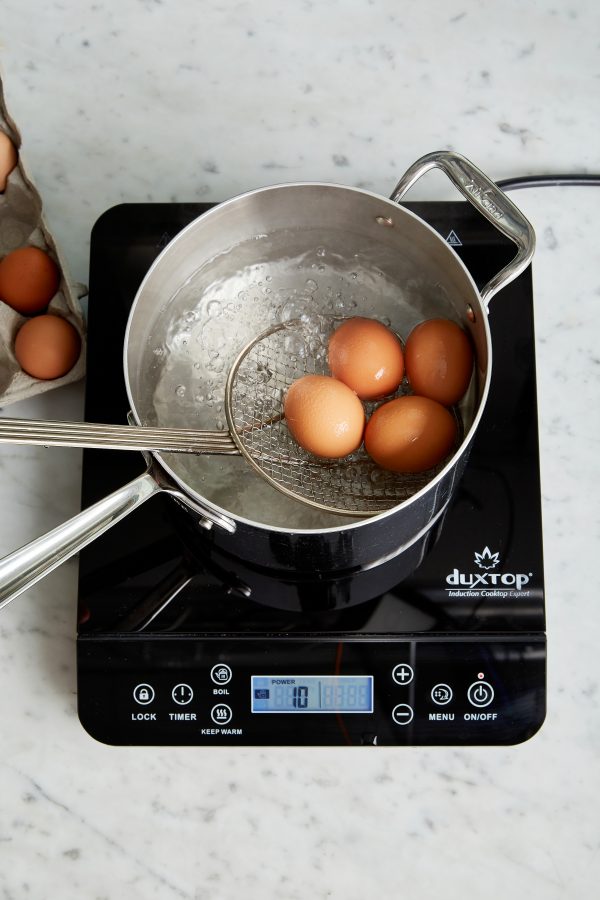
1. Lower the eggs into rapidly boiling water and cook them for 8 minutes 40 seconds.
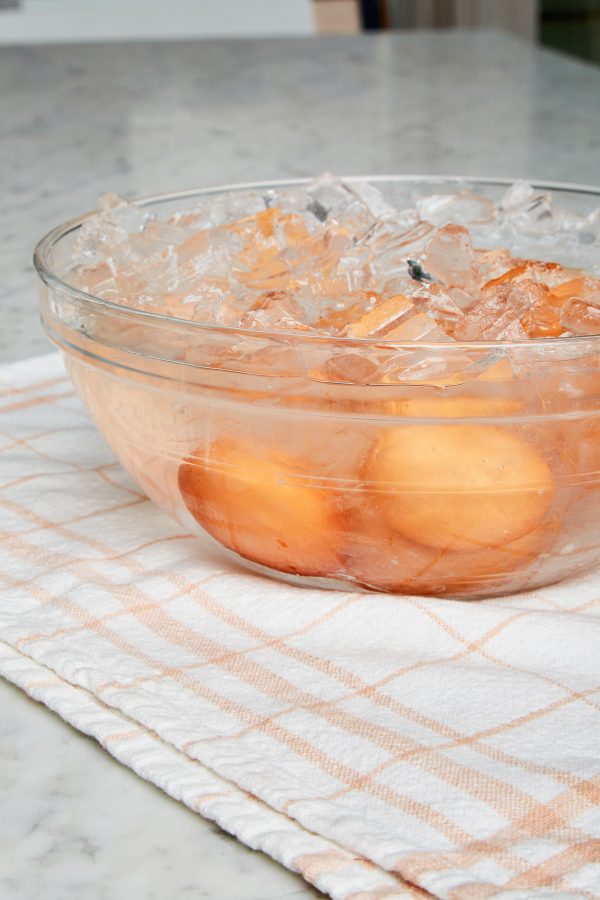
2. Fill a large bowl with ice water. Transfer the cooked eggs to an ice bath and cool for 3 minutes.
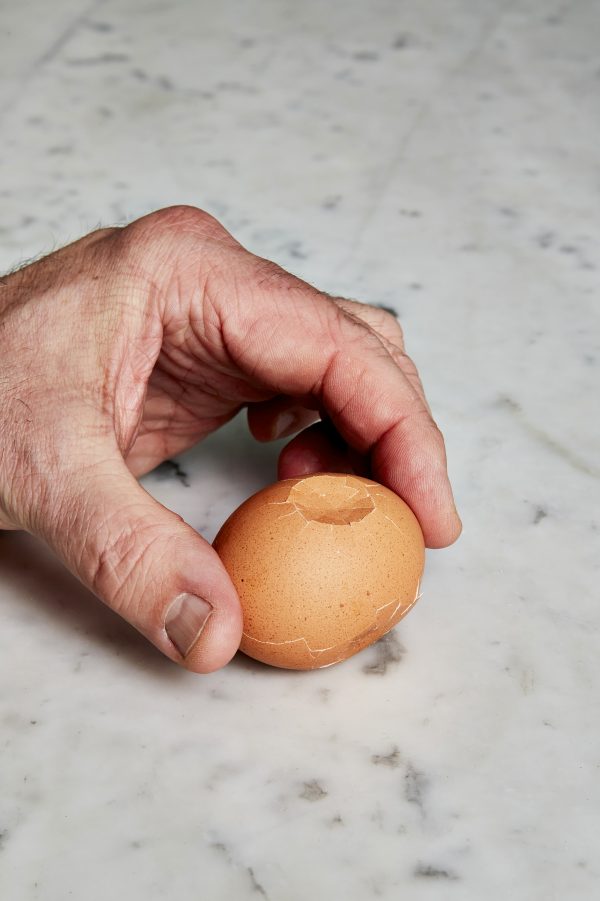
3. To peel, gently tap the eggs all around on a hard surface, then peel away the shell and membrane.
Related Recipes
May - June 2023

Sign up to receive texts
Successfully signed up to receive texts!
We'll only send our very best offers - Like a $15 store credit to start.
By entering your phone number and submitting this form, you consent to receive marketing text messages (such as promotion codes and cart reminders) from Christopher Kimball's Milk Street at the number provided, including messages sent by autodialer. Consent is not a condition of any purchase. Message and data rates may apply. Message frequency varies. You can unsubscribe at any time by replying STOP or clicking the unsubscribe link (where available) in one of our messages. View our Privacy Policy and Terms of Service.
